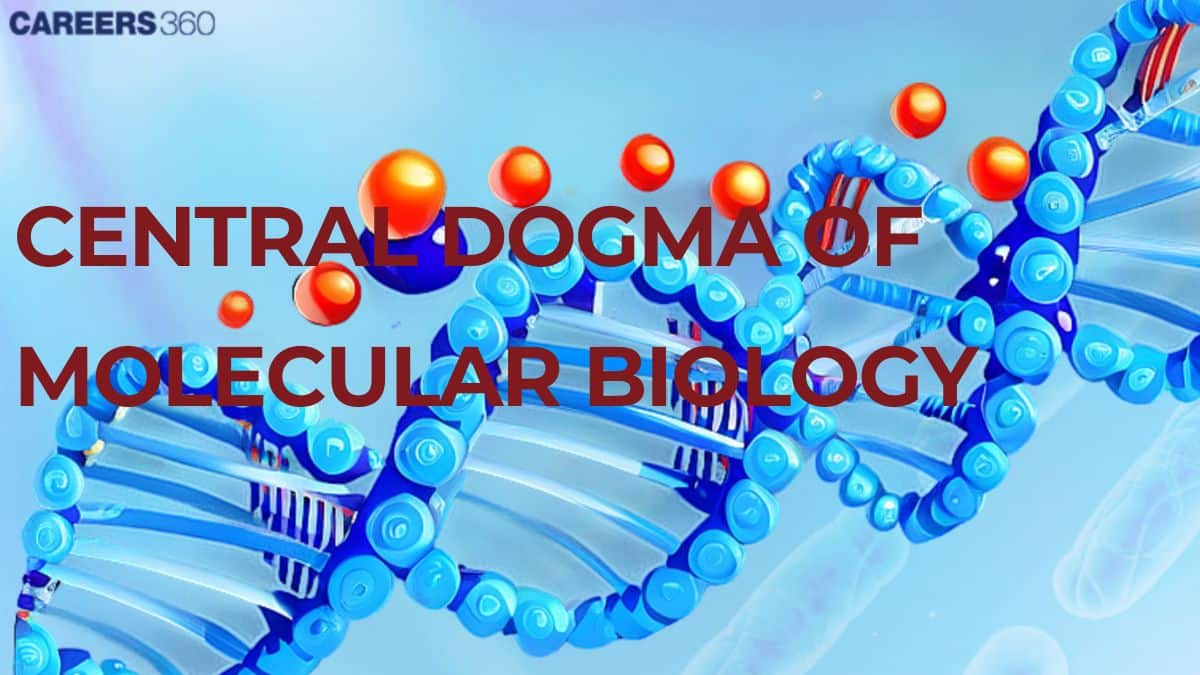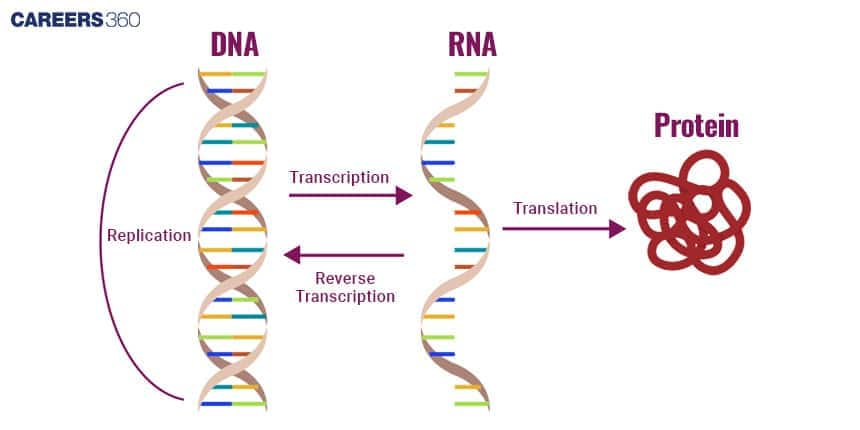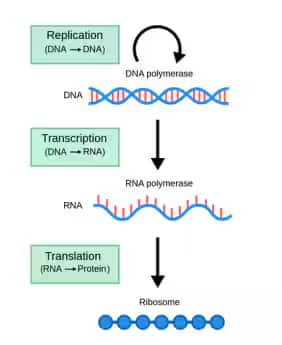Central Dogma of Molecular Biology: Steps and Diagram
The central dogma of molecular biology refers to the flow of genetic information in a biological system. It is stated as “DNA make RNA, and RNA makes protein”. The flow of genetic information from DNA to RNA to proteins is the central dogma of molecular biology. This makes sure that genes are expressed in a directional manner, necessary for all living organisms. It was first stated by Francis Crick in 1957, and was then published in 1958.
This Story also Contains
- What is the Central Dogma?
- Steps of Central Dogma
- Genetic Code
- Applications of Central Dogma
- MCQs on Central Dogma of Molecular Biology
- Recommended video for Central Dogma of Molecular Biology

In detail, it is the transfer of information from nucleic acid to nucleic acid (replication), or from nucleic acid to mRNA (transcription), and then mRNA to protein (translation). The transfer of information from protein to protein, or from protein to nucleic acid, is impossible. Information here refers to precise determination of sequence, either of bases in nucleic acid or of amino acid residues in the protein. Central dogma of molecular biology is a topic of the chapter Molecular Basis of Inheritance. It is an important chapter in the Biology subject.
What is the Central Dogma?
The central dogma of molecular biology tends to explain the flow of genetic information within a cell. It all starts with DNA, the hereditary material or genome that contains the information necessary to make and sustain life. DNA is a double-stranded molecule that is made up of nucleotide bases arranged in a definite sequence.
First, it is transcribed in a very similar molecule called RNA. It is a single-strand molecule to carries genetic information from DNA in the nucleus into the cytoplasm, where the ribosomes are. It differs from DNA because of uses another sugar, namely, ribose instead of deoxyribose, and one of its pyrimidines is uracil instead of thymine. Major types of RNA participating in this process are tRNAs, rRNAs, and above all, mRNAs, which become templates for proteins.
The last step in the central dogma is the translation of RNA into proteins. Proteins consist of amino acids and do anything from structural support and catalysis of biochemical reactions by acting as enzymes. This whole process is essential for the growth, development, and functioning of all living organisms.
Diagram: Central Dogma
The diagram below shows the flow of genetic information as per the central dogma.

Steps of Central Dogma
Three main steps compose the central dogma: replication, transcription, and translation. DNA copying into DNA is replication, DNA to mRNA is transcription, and mRNA to proteins is translation.
Replication
Mechanism of DNA Replication: The process of replication of DNA takes place just prior to cell division so that during cell division, every daughter cell receives a replica of the genetic material.
Enzymes Involved: Several key enzymes are involved, which include DNA polymerase. Other important enzymes include primase, which lays down RNA primer. Ligase, an enzyme that seals off gaps between the newly synthesised fragments of DNA.
Transcription
The process of transcription is the process by which a particular DNA segment is copied into RNA under the activity of the RNA polymerase enzyme. The mRNA takes the genetic information of DNA to the ribosomes in the second step.
RNA Polymerase Function: It binds to the promoter region of the gene. After this, it unwinds the strands of DNA so that it can read the template strand. The polymerase synthesises a complementary RNA strand by adding RNA nucleotides.
Transcriptional Stages: The transcription process can be divided into three major steps:
An initiation step where the RNA polymerase binds the promoter and initiates RNA synthesis
Elongation where RNA polymerase continues to add nucleotides to the chain of growing RNA
A termination step in which a termination signal is encountered by the RNA polymerase, halting and releasing the newly synthesised RNA.
Translation
The process of translation is the process whereby mRNA sequence is decoded to build proteins. The process takes place within the ribosomes, reading the sequence of mRNA in triplets of nucleotides called codons.
Ribosomes allow the binding of transfer RNA or tRNA molecules to the mRNA. With every tRNA comes an amino acid, a building block of proteins that is specific to a particular codon of the mRNA. The other constituents of the ribosome are ribosomal RNA or rRNA.
Steps in Translation: Translation occurs in three major steps.
Initiation, whereby the ribosome assembles around the mRNA and the first tRNA.
Elongation, where tRNAs bring amino acids to the ribosome to be added to the growing polypeptide chain.
Finally, termination, where the ribosome runs into a stop codon and the newly formed protein is released from the ribosome.
Genetic Code
There are various rules for the processes, which are programmed in the genetic code. It is simply the set of rules by which information encoded within mRNA is translated into proteins. Formed by codons, sequences of three nucleotides corresponding with specific amino acids or to stop signals during the synthesis of proteins, it includes all translation rules.
The universality of the genetic code in almost all organisms suggests its fundamental nature in biology. Each codon will then specify just one amino acid but with some redundancy, since more than one codon may code for the same amino acid. For example, the amino acid phenylalanine is encoded by the codons UUU and UUC.
The genetic code consists of start and stop codons. The start codon marks the initiation of translation and thus codes for the amino acid methionine; the sequence is AUG. Stop codons signal the termination of translation, which means the end of the protein. These include UAA, UAG, and UGA.
Genetic code accuracy is the basis for correctly synthesised proteins. Any type of mutation or error in the genetic code gives rise to malfunctioning proteins with great biological consequences.
Applications of Central Dogma
There are various applications, such as gene manipulation techniques, gene therapy, and in research areas as well. Such applications are described below-
Genetic Manipulation and CRISPR: Such is the foundational role of the central dogma in techniques of genetic engineering, such as CRISPR. It is a tool that can edit the DNA sequence with a high degree of precision. This could have potentially groundbreaking applications in treatments for genetic disorders and Increases in crop manipulation, among many others.
Gene Therapy: It is the introduction or modification of genes within a person's cells to prevent or treat disease. The application requires an understanding and manipulation of all the processes described within the central dogma.
Research and Diagnostics: DNA Sequencing Technologies for sequencing DNA, that is, decoding its string of letters, have transformed biological research and medical diagnostics. They help identification of genetic mutations associated with diseases.
PCR (Polymerase Chain Reaction): PCR is a technique used for amplifying specified DNA sequences, and thus it makes the analysis possible from minute amounts of DNA. application in research, forensic science, and medical diagnostics.
MCQs on Central Dogma of Molecular Biology
Q1. The diagram shows an important concept in the genetic implication of DNA. Fill in the blanks A to C.

Option 1: A - translation B - extension C - Rosalind Franklin
Option 2: A - transcription B - replication C - James Watson
Option 3: A - translation B - transcription C - Erevin Chargaff
Option 4: A - transcription B - translation C - Francis Crick
Correct answer: (4) A - transcription B - translation C - Francis Crick.
Explanation:
Francis Crick put forward the central dogma of molecular biology describing the flow of genetic information as DNA → RNA → Protein. The concept first proposed in 1957 made clear that the information transfers from nucleic acids to proteins; hence, it cannot return once it's in protein form. The central dogma is a foundational understanding of the processes in cellular but has had its exceptions discovered since its conception 135 years ago in the form of reverse transcription in retroviruses.
Hence, the correct answer is Option (4) A - transcription B - translation C - Francis Crick.
Q2. Which one of the following does not follow the central dogma of molecular biology?
Option 1: HIV
Option 2: Pea
Option 3: Mucor
Option 4: Chlamydomonas
Correct answer: 1) HIV
Explanation:
Because HIV, as a retrovirus, deviates from the central dogma instead of producing proteins from DNA, it uses host cells to produce DNA from the virus's RNA so the correct option is 'HIV'. Because HIV, as a retrovirus, deviates from the central dogma, instead of producing proteins from DNA, it uses host cells to produce DNA from the virus's RNA. This process is known as reverse transcription, where the viral enzyme reverse transcriptase converts the RNA genome into complementary DNA (cDNA). The cDNA then integrates into the host cell’s genome, allowing the virus to replicate and produce new viral particles. This unique mechanism of replication challenges the typical flow of genetic information outlined by the central dogma of molecular biology.
Hence, the correct answer is option 1) HIV
Q3. Which of the following most accurately describes the central dogma of biology?
Option 1: RNA to protein to DNA
Option 2: DNA to RNA to protein
Option 3: DNA to protein to RNA
Option 4: Protein to RNA to DNA
Correct answer: 2) DNA to RNA to protein
Explanation:
The central dogma of biology dictates that the coded genetic information stored in DNA is transcribed into single-stranded RNA, which is then translated into protein.
The central dogma states that the pattern of information that occurs most frequently in our cells is:
From existing DNA to make new DNA (DNA replication)
From DNA to make new RNA (transcription)
From RNA to make new proteins (translation).

Hence, the correct answer is option 2) DNA to RNA to protein
Recommended video for Central Dogma of Molecular Biology
Frequently Asked Questions (FAQs)
The three most important processes are DNA replication, RNA transcription, and protein translation.
The effect of mutation may change the DNA sequence and further can result in changes in the mRNA and the protein that is formed. This will thus affect the traits and functions of the organism.
Genetic engineering, gene therapy, and diagnostics like DNA sequencing and PCR.
This is of vital importance if one is to understand how genetic information is passed on and expressed within living things.